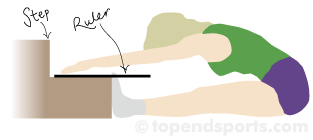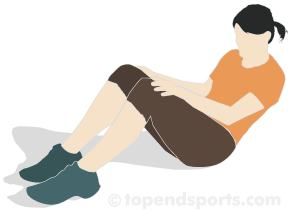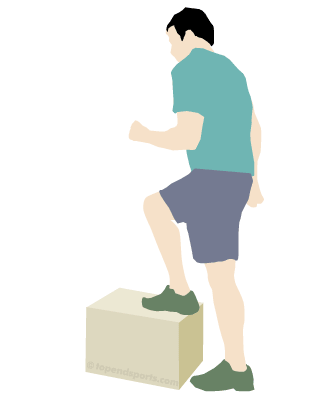
Extreme People,
Get ready to test yourself. Start by testing your BMI and then work on a little warm up before moving on to the other tests. You will want to keep track of your progress, so don't forget to write your score down and how well you did. Plus, you can post it and show off or just let me know how you are doing.
The standard weight status categories associated with BMI ranges for adults are shown in the following table.
BMI | Weight Status |
|---|---|
| Below 18.5 | Underweight |
| 18.5 – 24.9 | Normal |
| 25.0 – 29.9 | Overweight |
| 30.0 and Above | Obese |
General Warm Up Procedure
Here is a general warm up procedure that you can use as a basis for your testing. This is only a guide and you can adapt it based on the time and facilities that you have available. You may wish to include other stretches when a certain part of the body is to be specifically tested. See also the specific test warm-ups below.
- 5-10 minutes of light aerobic activity, such as jogging or stationary cycling.
- stretches to include both upper and lower body. e.g.
- lunges
- quad stretch
- calf stretch
- side bend
- arm stretches
1. Push Up Test

How many can you do? Men should use the standard "military style" pushup position with only the hands and the toes touching the floor. Women have the additional option of using the "bent knee" position. To do this, kneel on the floor, hands on either side of the chest and keep your back straight. Do as many push ups as possible until exhaustion. Count the total number of pushups performed. Use the chart below to find out how you rate.
How did you do?
Push Up Test (Men)
| | | Age 30-39 | | | | |
|---|---|---|---|---|---|---|
| Excellent | > 56 | > 47 | > 41 | > 34 | > 31 | > 30 |
| Good | 47-56 | 39-47 | 34-41 | 28-34 | 25-31 | 24-30 |
| Above average | 35-46 | 30-39 | 25-33 | 21-28 | 18-24 | 17-23 |
| Average | 19-34 | 17-29 | 13-24 | 11-20 | 9-17 | 6-16 |
| Below average | 11-18 | 10-16 | 8-12 | 6-10 | 5-8 | 3-5 |
| Poor | 4-10 | 4-9 | 2-7 | 1-5 | 1-4 | 1-2 |
| Very Poor | < 4 | < 4 | < 2 | 0 | 0 | 0 |
| Age | 17-19 | 20-29 | 30-39 | 40-49 | 50-59 | 60-65 |
|---|---|---|---|---|---|---|
| Excellent | > 35 | > 36 | > 37 | > 31 | > 25 | > 23 |
| Good | 27-35 | 30-36 | 30-37 | 25-31 | 21-25 | 19-23 |
| Above Average | 21-27 | 23-29 | 22-30 | 18-24 | 15-20 | 13-18 |
| Average | 11-20 | 12-22 | 10-21 | 8-17 | 7-14 | 5-12 |
| Below average | 6-10 | 7-11 | 5-9 | 4-7 | 3-6 | 2-4 |
| Poor | 2-5 | 2-6 | 1-4 | 1-3 | 1-2 | 1 |
| Very Poor | 0-1 | 0-1 | 0 | 0 | 0 | 0 |
Starting Position: Lie on a carpeted or cushioned floor with your knees bent at approximately right angles, with feet flat on the ground. Your hands should be resting on your thighs.
Technique: Squeeze your stomach, push your back flat and raise high enough for your hands to slide along your thighs to touch the tops of your knees. Don't pull with you neck or head and keep your lower back on the floor. Then return to the starting position.
How did you do?
Compare your results to the table below. Remember, these scores are based on doing the tests as described, and may not be accurate if the test is modified at all. Don't worry too much about how you rate - just try and improve your own score.1 Minute Sit Up Test (Men)
| Age | 18-25 | 26-35 | 36-45 | 46-55 | 56-65 | 65+ |
|---|---|---|---|---|---|---|
| Excellent | >49 | >45 | >41 | >35 | >31 | >28 |
| Good | 44-49 | 40-45 | 35-41 | 29-35 | 25-31 | 22-28 |
| Above average | 39-43 | 35-39 | 30-34 | 25-28 | 21-24 | 19-21 |
| Average | 35-38 | 31-34 | 27-29 | 22-24 | 17-20 | 15-18 |
| Below Average | 31-34 | 29-30 | 23-26 | 18-21 | 13-16 | 11-14 |
| Poor | 25-30 | 22-28 | 17-22 | 13-17 | 9-12 | 7-10 |
| Very Poor | <25 | <22 | <17 | <13 | <9 | <7 |
1 Minute Sit Up Test (Women)
| Age | 18-25 | 26-35 | 36-45 | 46-55 | 56-65 | 65+ |
|---|---|---|---|---|---|---|
| Excellent | >43 | >39 | >33 | >27 | >24 | >23 |
| Good | 37-43 | 33-39 | 27-33 | 22-27 | 18-24 | 17-23 |
| Above average | 33-36 | 29-32 | 23-26 | 18-21 | 13-17 | 14-16 |
| Average | 29-32 | 25-28 | 19-22 | 14-17 | 10-12 | 11-13 |
| Below Average | 25-28 | 21-24 | 15-18 | 10-13 | 7-9 | 5-10 |
| Poor | 18-24 | 13-20 | 7-14 | 5-9 | 3-6 | 2-4 |
| Very Poor | <18 | <13 | <7 | <5 | <3 | <2 |
3.Squat Test

How many squats can you do? Stand in front of a chair or bench with your feet at shoulder's width apart, facing away from it. Place your hands on your hips. Squat down and lightly touch the chair before standing back up. A good sized chair is one that makes your knees at right angles when you are sitting. Keep doing this until you're fatigued.
How did you go?
Compare your results to the table below. Remember, these scores are based on doing the tests as described, and will lose accuracy if the test is modified, including using a higher or lower chair. In reality, you shouldn't worry too much about how you rate - just try and improve your own score. These figures can just be a guide.Squat Test (Men)
| Age | 20-29 | 30-39 | 40-49 | 50-59 | 60+ |
|---|---|---|---|---|---|
| Excellent | > 34 | > 32 | > 29 | > 26 | > 23 |
| Good | 33-34 | 30-32 | 27-29 | 24-26 | 21-23 |
| Above average | 30-32 | 27-29 | 24-26 | 21-23 | 18-20 |
| Average | 27-29 | 24-26 | 21-23 | 18-20 | 15-17 |
| Below Average | 24-26 | 21-23 | 18-20 | 15-17 | 12-14 |
| Poor | 21-23 | 18-20 | 15-17 | 12-14 | 9-11 |
| Very Poor | < 21 | < 18 | <15 | <12 | <9 |
Squat Test (Women)
| Age | 20-29 | 30-39 | 40-49 | 50-59 | 60+ |
|---|---|---|---|---|---|
| Excellent | >29 | >26 | >23 | >20 | >17 |
| Good | 27-29 | 24-26 | 21-23 | 18-20 | 15-17 |
| Above average | 24-26 | 21-23 | 18-20 | 15-17 | 12-14 |
| Average | 21-23 | 18-20 | 15-17 | 12-14 | 9-11 |
| Below Average | 18-20 | 15-17 | 12-14 | 9-11 | 6-8 |
| Poor | 15-17 | 12-14 | 9-11 | 6-8 | 3-5 |
| Very Poor | <15 | <12 | <9 | <6 | <3 |
Equipment
- a 12 inch high bench (or a similar sized stair or sturdy box), watch for timing minutes.
Procedure
Step on and off the box for three minutes. Step up with one foot and then the other. Step down with one foot followed by the other foot. Try to maintain a steady four beat cycle. It's easy to maintain if you say "up, up, down, down". Go at a steady and consistent pace.Measurement
At the end of 3 minutes, remain standing while you immediately check your heart rate. Take your pulse for one minute (e.g. count the total beats from 3 to 4 minutes after starting the test). Go here for more information about measuring your heart rate.How did you do?
3 Minute Step Test (Men) - Heart Rate
| Age | 18-25 | 26-35 | 36-45 | 46-55 | 56-65 | 65+ |
|---|---|---|---|---|---|---|
| Excellent | <79 | <81 | <83 | <87 | <86 | <88 |
| Good | 79-89 | 81-89 | 83-96 | 87-97 | 86-97 | 88-96 |
| Above Average | 90-99 | 90-99 | 97-103 | 98-105 | 98-103 | 97-103 |
| Average | 100-105 | 100-107 | 104-112 | 106-116 | 104-112 | 104-113 |
| Below Average | 106-116 | 108-117 | 113-119 | 117-122 | 113-120 | 114-120 |
| Poor | 117-128 | 118-128 | 120-130 | 123-132 | 121-129 | 121-130 |
| Very Poor | >128 | >128 | >130 | >132 | >129 | >130 |
3 Minute Step Test (Women) - Heart Rate
| Age | 18-25 | 26-35 | 36-45 | 46-55 | 56-65 | 65+ |
|---|---|---|---|---|---|---|
| Excellent | <85 | <88 | <90 | <94 | <95 | <90 |
| Good | 85-98 | 88-99 | 90-102 | 94-104 | 95-104 | 90-102 |
| Above Average | 99-108 | 100-111 | 103-110 | 105-115 | 105-112 | 103-115 |
| Average | 109-117 | 112-119 | 111-118 | 116-120 | 113-118 | 116-122 |
| Below Average | 118-126 | 120-126 | 119-128 | 121-129 | 119-128 | 123-128 |
| Poor | 127-140 | 127-138 | 129-140 | 130-135 | 129-139 | 129-134 |
| Very Poor | >140 | >138 | >140 | >135 | >139 | >134 |
This test is designed to measure your explosive leg lower. All you need is a a high wall, such as the outside of a building, and a bit of room so you can jump and land safely.
Start by standing side on to a wall and reach up as high as you can with the hand closest to the wall. Make note of how high you can reach. This is called the standing reach height. Then stand a little away from the wall, and jump high as possible using both arms and legs to assist in projecting the body upwards. Attempt to touch the wall at the highest point of the jump. Make note of where you touched the wall at the height of the jump. Measure the distance between the standing reach height and the maximum jump height, and that is your result.
You can assist in recording your score by holding a piece of chalk in your had and using it to mark the wall. If the wall already has horizontal lines, such as a brick wall, it will be easier to mark your jump height. Have as many attempts as you need to get the best possible score. Practice your technique, as the jump height can be affected by how much you bend your knees before jumping, and the effective use of the arms.
How did you do?
Compare your results to the table below. Remember, these scores are based on doing the tests as described, and may not be accurate if the test is modified at all. Don't worry too much about how you rate - just try and improve your own score.| rating | males (inches) | males (cm) | females (inches) | females (cm) |
|---|---|---|---|---|
| excellent | > 28 | > 70 | > 24 | > 60 |
| very good | 24 - 28 | 61-70 | 20 - 24 | 51-60 |
| above average | 20 - 24 | 51-60 | 16 - 20 | 41-50 |
| average | 16 - 20 | 41-50 | 12 - 16 | 31-40 |
| below average | 12 - 16 | 31-40 | 8 - 12 | 21-30 |
| poor | < 12 | < 30 | < 8 | < 20 |
- ruler, step
5. Sit & Reach Flexibility

Equipment



Almost scared to do this. 2.5 years ago I was ready to run a half marathon. One knee injury and a severe hormone problem later I am 35 pounds heavier. I am even bigger than after I had my son who is 4. Your blog is amazing and I am really excited to get back to who I was before. You are a blessing from God. Thank you.
ReplyDeleteJennifer, I know the feeling but you can do anything you set your mind to. Reach for the stars and you will catch one. Write down your goals and go for it.
Delete